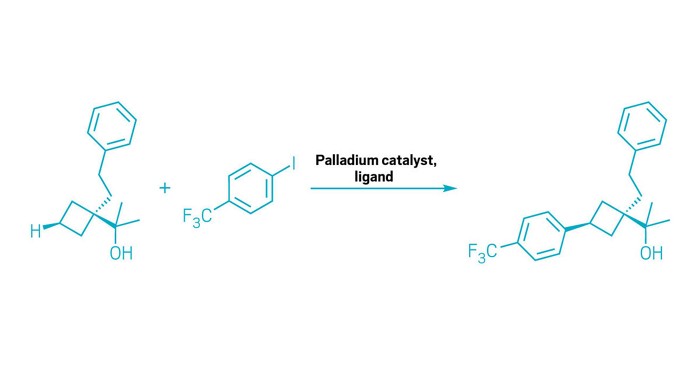Advertisement
Grab your lab coat. Let's get started
Welcome!
Welcome!
Create an account below to get 6 C&EN articles per month, receive newsletters and more - all free.
It seems this is your first time logging in online. Please enter the following information to continue.
As an ACS member you automatically get access to this site. All we need is few more details to create your reading experience.
Not you? Sign in with a different account.
Not you? Sign in with a different account.
ERROR 1
ERROR 1
ERROR 2
ERROR 2
ERROR 2
ERROR 2
ERROR 2
Password and Confirm password must match.
If you have an ACS member number, please enter it here so we can link this account to your membership. (optional)
ERROR 2
ACS values your privacy. By submitting your information, you are gaining access to C&EN and subscribing to our weekly newsletter. We use the information you provide to make your reading experience better, and we will never sell your data to third party members.
C-H Activation
Mechanochemical reaction oxidizes C–H bonds in polymers
The iron-catalyzed method selectively adds hydroxyl groups to traditionally insoluble molecules at room temperature
by XiaoZhi Lim, special to C&EN
May 6, 2024

With millions of tons of plastic going into landfills every year, chemists are racing to find end-of-life uses for materials like polystyrene. But these large polymers are notoriously hard to dissolve, making them unsuitable for many industrial reactions that take place in solution.
Plastics could get a second life thanks to an iron-based catalyst that is now proved to work in solvent-free conditions (ACS. Catal. 2024, DOI: 10.1021/acscatal.4c00775). The reaction replaces the hydrogen atoms only on tertiary carbons with hydroxyl groups and leaves other C–H be. The researchers could functionalize not only hard-to-dissolve small molecules but also polymer molecules that are chock-full of C–H bonds.
Many polymers typically dissolve well only in the toxic, chlorinated solvents—an unimaginable choice for the massive volumes at which they would be needed for dealing with plastic waste, according to Sayam Sen Gupta, a green chemist at the Indian Institute of Science Education and Research Kolkata whose lab developed the new reaction. As green chemists, “we can’t even think about [using] these kinds of solvents,” he says.

Gupta’s team developed the iron catalyst in 2017 and intended it to mimic cytochrome P450 enzymes, which serve as redox catalysts in nature. The researchers coaxed the catalyst to tack oxygen atoms onto small molecules in organic solvents and eventually got it to work in water like the enzymes do (Chem. Sci. 2023, DOI: 10.1039/D3SC03495J).
But some of the chemists’ desired targets are insoluble in water—such as adamantane, a vital ingredient in pharmaceutical manufacturing. Committed to making a green reaction, Gupta’s team turned to mechanochemistry.
By grinding solid reactants and their catalyst at room temperature, the group hydroxylated almost exclusively the tertiary C–H bonds on more than a dozen small molecules. What’s more, the reaction’s oxidant is sodium percarbonate, a green household bleach.
Swaminathan Sivaram, a polymer chemist now at the Indian Institute of Science Education and Research Pune, then suggested that Gupta test the reaction on polymers with tertiary C–H bonds, such as polystyrene. The researchers managed to incorporate around 5 hydroxyl groups for every 100 or so monomer units while keeping the polystyrene molecules intact.
This is a comparatively high degree of functionalization for a mechanochemical treatment of polymers, says Ina Vollmer, a polymer chemist at Utrecht University who was not involved in the study. That and the reaction’s high selectivity present interesting opportunities beyond degradation or recycling, she adds.
Vollmer is also developing mechanochemical ways to break down polymers into monomers. But “when I talk to companies, they always say, ‘Why don’t you make something more valuable out of the polymer, like functionalizing it?’” she says. “So, I think [this reaction] would be something of much interest.”
While the researchers have yet to identify a specific use for the hydroxylated polymers, Sivaram points out that they might be similar to polar ethylene-vinyl alcohol copolymers. These are contained in multilayer packaging commonly used to wrap foods such as potato chips, chocolate, and pet food.
Susannah Scott, a chemist at the University of California, Santa Barbara, agrees that the reaction’s selectivity and ability to preserve the polymer chains is “unusual.” But it needs to be proved with polymers of higher molecular weight that “better represent commercial plastics,” she writes in an email. Scott and Vollmer note that polystyrene has been shown to depolymerize in ball mills.
In addition to investigating the properties of the partially oxidized polymers, the authors of the new study plan to test the reaction on lignocellulose, one of the most common forms of waste biomass and a notoriously insoluble polymer.
CORRECTION:
This story was updated May 8, 2024, because the order of the captions was inverted.



Join the conversation
Contact the reporter
Submit a Letter to the Editor for publication
Engage with us on Twitter